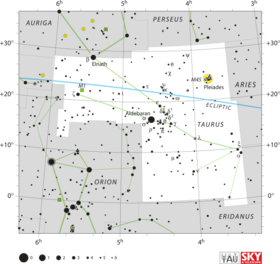Astronomy:Mu Tauri
| Observation data Equinox J2000.0]] (ICRS) | |
|---|---|
| Constellation | Taurus |
| Right ascension | 04h 15m 32.05687s[1] |
| Declination | 08° 53′ 32.4916″[1] |
| Apparent magnitude (V) | 4.27[2] |
| Characteristics | |
| Spectral type | B3IV[3] |
| U−B color index | −0.51[4] |
| B−V color index | −0.05[4] |
| Astrometry | |
| Radial velocity (Rv) | +16.3±0.6[5] km/s |
| Proper motion (μ) | RA: +20.881[1] mas/yr Dec.: −22.789[1] mas/yr |
| Parallax (π) | 6.6651 ± 0.3319[1] mas |
| Distance | 490 ± 20 ly (150 ± 7 pc) |
| Absolute magnitude (MV) | −1.45[2] |
| Details | |
| Mass | 6.7[6] M☉ |
| Luminosity | 462[2] L☉ |
| Surface gravity (log g) | 3.75[7] cgs |
| Temperature | 16,980[7] K |
| Metallicity [Fe/H] | −0.16[2] dex |
| Rotational velocity (v sin i) | 89[8] km/s |
| Age | 252[9] Myr |
| Other designations | |
| Database references | |
| SIMBAD | data |
μ Tauri, Latinized as Mu Tauri, is a single[11] star in the equatorial constellation of Taurus. It has a blue-white hue and is faintly visible to the naked eye with an apparent visual magnitude of 4.27.[2] The star is located approximately 490 light years distant from the Sun based on parallax,[1] and is drifting further away with a radial velocity of +16 km/s.[5]
This object has a stellar classification of B3IV,[3] matching a B-type subgiant star. In the past this star was thought to have a variable radial velocity, but is now considered constant.[12] It is 252[9] million years old and is spinning with a projected rotational velocity of 89 km/s.[8] The star has 6.7[6] times the mass of the Sun and is radiating 462[2] times the Sun's luminosity from its photosphere at an effective temperature of 16,980 K.[7] It is emitting an infrared excess at a wavelength of 18 μm, making it a candidate host of a faint warm debris disk.[13]
References
- ↑ 1.0 1.1 1.2 1.3 1.4 1.5 Brown, A. G. A. (August 2018). "Gaia Data Release 2: Summary of the contents and survey properties". Astronomy & Astrophysics 616: A1. doi:10.1051/0004-6361/201833051. Bibcode: 2018A&A...616A...1G. Gaia DR2 record for this source at VizieR.
- ↑ 2.0 2.1 2.2 2.3 2.4 2.5 Anderson, E.; Francis, Ch. (2012). "XHIP: An extended hipparcos compilation". Astronomy Letters 38 (5): 331. doi:10.1134/S1063773712050015. Bibcode: 2012AstL...38..331A. Vizier catalog entry
- ↑ 3.0 3.1 Lesh, Janet Rountree (December 1968), "The Kinematics of the Gould Belt: an Expanding Group?", Astrophysical Journal Supplement 17: 371, doi:10.1086/190179, Bibcode: 1968ApJS...17..371L
- ↑ 4.0 4.1 Mallama, A. (2014). "Sloan Magnitudes for the Brightest Stars". The Journal of the American Association of Variable Star Observers 42 (2): 443. Bibcode: 2014JAVSO..42..443M.Vizier catalog entry
- ↑ 5.0 5.1 Gontcharov, G. A. (2006). "Pulkovo Compilation of Radial Velocities for 35 495 Hipparcos stars in a common system". Astronomy Letters 32 (11): 759–771. doi:10.1134/S1063773706110065. Bibcode: 2006AstL...32..759G.
- ↑ 6.0 6.1 Tetzlaff, N. et al. (2011). "A catalogue of young runaway Hipparcos stars within 3 kpc from the Sun". Monthly Notices of the Royal Astronomical Society 410 (1): 190–200. doi:10.1111/j.1365-2966.2010.17434.x. Bibcode: 2011MNRAS.410..190T. Vizier catalog entry
- ↑ 7.0 7.1 7.2 Soubiran, Caroline et al. (2016). "The PASTEL catalogue: 2016 version". Astronomy & Astrophysics 591: A118. doi:10.1051/0004-6361/201628497. Bibcode: 2016A&A...591A.118S.
- ↑ 8.0 8.1 Hoffleit, D.; Warren, W. H. (1995). "Bright Star Catalogue". VizieR On-line Data Catalog: V/50. Originally Published in: 1964BS....C......0H 5050. Bibcode: 1995yCat.5050....0H.
- ↑ 9.0 9.1 Gontcharov, G. A. (November 2012), "Spatial distribution and kinematics of OB stars", Astronomy Letters 38 (11): 694–706, doi:10.1134/S1063773712110035, Bibcode: 2012AstL...38..694G
- ↑ "mu Tau". SIMBAD. Centre de données astronomiques de Strasbourg. http://simbad.u-strasbg.fr/simbad/sim-basic?Ident=mu+Tau.
- ↑ Eggleton, P. P.; Tokovinin, A. A. (September 2008). "A catalogue of multiplicity among bright stellar systems". Monthly Notices of the Royal Astronomical Society 389 (2): 869–879. doi:10.1111/j.1365-2966.2008.13596.x. Bibcode: 2008MNRAS.389..869E.
- ↑ Percy, J. R.; Lane, M. C. (May 1977). "Search for Beta Cephei stars. I - Photometric and spectroscopic studies of northern B-type stars". Astronomical Journal 82: 353–359. doi:10.1086/112057. Bibcode: 1977AJ.....82..353P.
- ↑ Ishihara, Daisuke et al. (May 2017). "Faint warm debris disks around nearby bright stars explored by AKARI and IRSF". Astronomy & Astrophysics 601: 18. doi:10.1051/0004-6361/201526215. A72. Bibcode: 2017A&A...601A..72I.
 |


